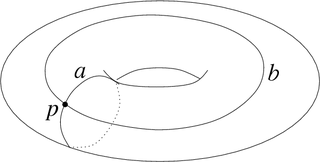In mathematics, the term path space refers to any topological space of paths from one specified set into another. In particular, it may refer to:

Mathematics includes the study of such topics as quantity, structure, space, and change.
In topology and related branches of mathematics, a topological space may be defined as a set of points, along with a set of neighbourhoods for each point, satisfying a set of axioms relating points and neighbourhoods. The definition of a topological space relies only upon set theory and is the most general notion of a mathematical space that allows for the definition of concepts such as continuity, connectedness, and convergence. Other spaces, such as manifolds and metric spaces, are specializations of topological spaces with extra structures or constraints. Being so general, topological spaces are a central unifying notion and appear in virtually every branch of modern mathematics. The branch of mathematics that studies topological spaces in their own right is called point-set topology or general topology.

In mathematics, a path in a topological space X is a continuous function f from the unit interval I = [0,1] to X
- The classical Wiener space of continuous paths
- The Skorokhod space of càdlàg paths
- For the usage in algebraic topology (until the article path space is created), see Glossary of algebraic topology#path space. For Moore's path space, see path space fibration#Moore's path space.

In mathematics, classical Wiener space is the collection of all continuous functions on a given domain, taking values in a metric space. Classical Wiener space is useful in the study of stochastic processes whose sample paths are continuous functions. It is named after the American mathematician Norbert Wiener.
In mathematics, a continuous function is a function for which sufficiently small changes in the input result in arbitrarily small changes in the output. Otherwise, a function is said to be a discontinuous function. A continuous function with a continuous inverse function is called a homeomorphism.
In mathematics, a càdlàg, RCLL, or corlol function is a function defined on the real numbers that is everywhere right-continuous and has left limits everywhere. Càdlàg functions are important in the study of stochastic processes that admit jumps, unlike Brownian motion, which has continuous sample paths. The collection of càdlàg functions on a given domain is known as Skorokhod space.
See also: loop space, the space of loops in a topological space
In topology, a branch of mathematics, the loop space ΩX of a pointed topological space X is the space of (based) loops in X, i.e. maps from the circle S1 to X, equipped with the compact-open topology. Two loops can be multiplied by concatenation. With this operation, the loop space is an A∞-space. That is, the multiplication is homotopy coherently associative.

In mathematics, a loop in a topological space X is a continuous function f from the unit interval I = [0,1] to X such that f(0) = f(1). In other words, it is a path whose initial point is equal to its terminal point.
| This disambiguation page lists articles associated with the title Path space. If an internal link led you here, you may wish to change the link to point directly to the intended article. |



